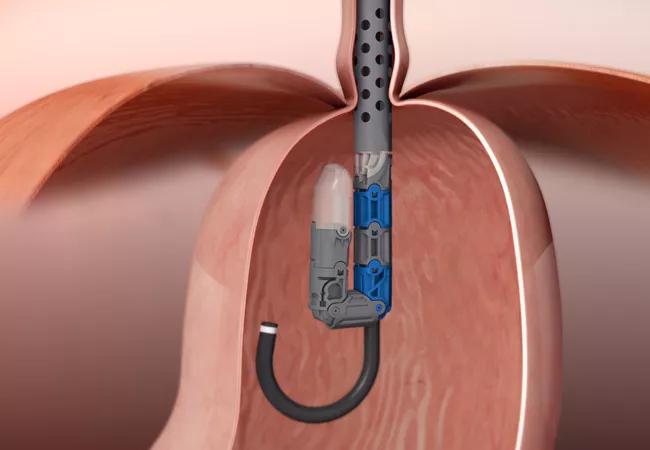Transoral incisionless fundoplication an effective, new option

After many years without any major new innovations to treat gastroesophageal reflux disease, transoral incisionless fundoplication (TIF) is offering hope to patients and physicians concerned about the long-term safety of current medical management or the risks associated with traditional laparoscopic surgery.
Advertisement
Cleveland Clinic is a non-profit academic medical center. Advertising on our site helps support our mission. We do not endorse non-Cleveland Clinic products or services. Policy
“Over the last few years some newer therapies have started to emerge. What we’re trying to do is bridge that gap between taking a pill or having an operation done, and that is where TIF comes in,” says Cleveland Clinic general surgeon John Rodriguez, MD. “For many, many years, treatment fell into one of two categories: taking a pill, a protein pump inhibitor … or an antireflux operation, also known as fundoplication.”
TIF is less invasive than laparoscopy. It’s an endoscopic technique done through the mouth as an outpatient procedure. TIF is also associated with “very minimal postoperative recovery,” Dr. Rodriguez says. “The recovery part of it is very attractive for patients. A lot of the physical limitations that follow a laparoscopic operation are not going to be there for TIF.”
“The data coming out from the larger series shows the procedure is very effective, showing very similar results to surgery and medical treatment,” Dr. Rodriguez says. “It looks promising.”
Gastrointestinal reflux disease (GERD) is a chronic form of reflux where stomach contents continue come up into the esophagus and cause distressing symptoms. GERD is also relatively common, affecting an estimated 20 percent of the U.S. population, the National Institute of Diabetes and Digestive and Kidney Diseases reports.
The proportion of people with GERD who may be candidates for the new procedure is also relatively large. “As long as your body mass index is below 35, and you don’t have a hiatal hernia larger than 2 cm, you’re generally a candidate for TIF,” Dr. Rodriguez says.
Advertisement

EsophyXTM device (EndoGastric® Solutions) inside with endoscope.
Nonetheless, there are exceptions. TIF is considered on an individualized basis for patients at Cleveland Clinic, with both Dr. Rodriguez and Madhusudhan Sanaka, MD, trained and accredited to perform the procedure. “This is not for everybody, especially in an era where we’re struggling with an obesity epidemic. We see a lot of patients referred to us for reflux and they ended up getting worked up for bariatric surgery.”
“The important thing for referring physicians to know is when they send their patients to us, the patient is going to get the very best therapy tailored to what their needs and expectations are,” Dr. Rodriguez adds.
Even though this new endoscopic technique for GERD has been available for a couple of years, “we’ve been waiting for studies to come out that show the therapy is effective,” Dr. Rodriguez says.
“That’s a key point when you look at medical innovation,” he says. “There can be a very fine line between trying new therapies that look innovative and are very attractive … because they are less invasive and they offer faster recovery, but you also have to be careful. You don’t want to compromise the quality of care you’re offering patients.”
“When we start doing new things ― and this is a good example of it ― you have to make sure you’re offering equivalent results compared to the standard of care,” Dr. Rodriguez says.
“The advantage for us in treating patients with GERD as a disease at Cleveland Clinic is that we offer the whole gamut of options. We have GI experts and surgeons that specialize in medical management, surgical management, and now we’re incorporating some of these newer techniques.”
Advertisement
Advertisement

Study reveals key differences between antibiotics, but treatment decisions should still consider patient factors

Key points highlight the critical role of surveillance, as well as opportunities for further advancement in genetic counseling

Potentially cost-effective addition to standard GERD management in post-transplant patients

Findings could help clinicians make more informed decisions about medication recommendations

Insights from Dr. de Buck on his background, colorectal surgery and the future of IBD care

Retrospective analysis looks at data from more than 5000 patients across 40 years

Surgical intervention linked to increased lifespan and reduced complications

Diagnostic and management pearls for an emerging condition linking tick-bites to meat allergy